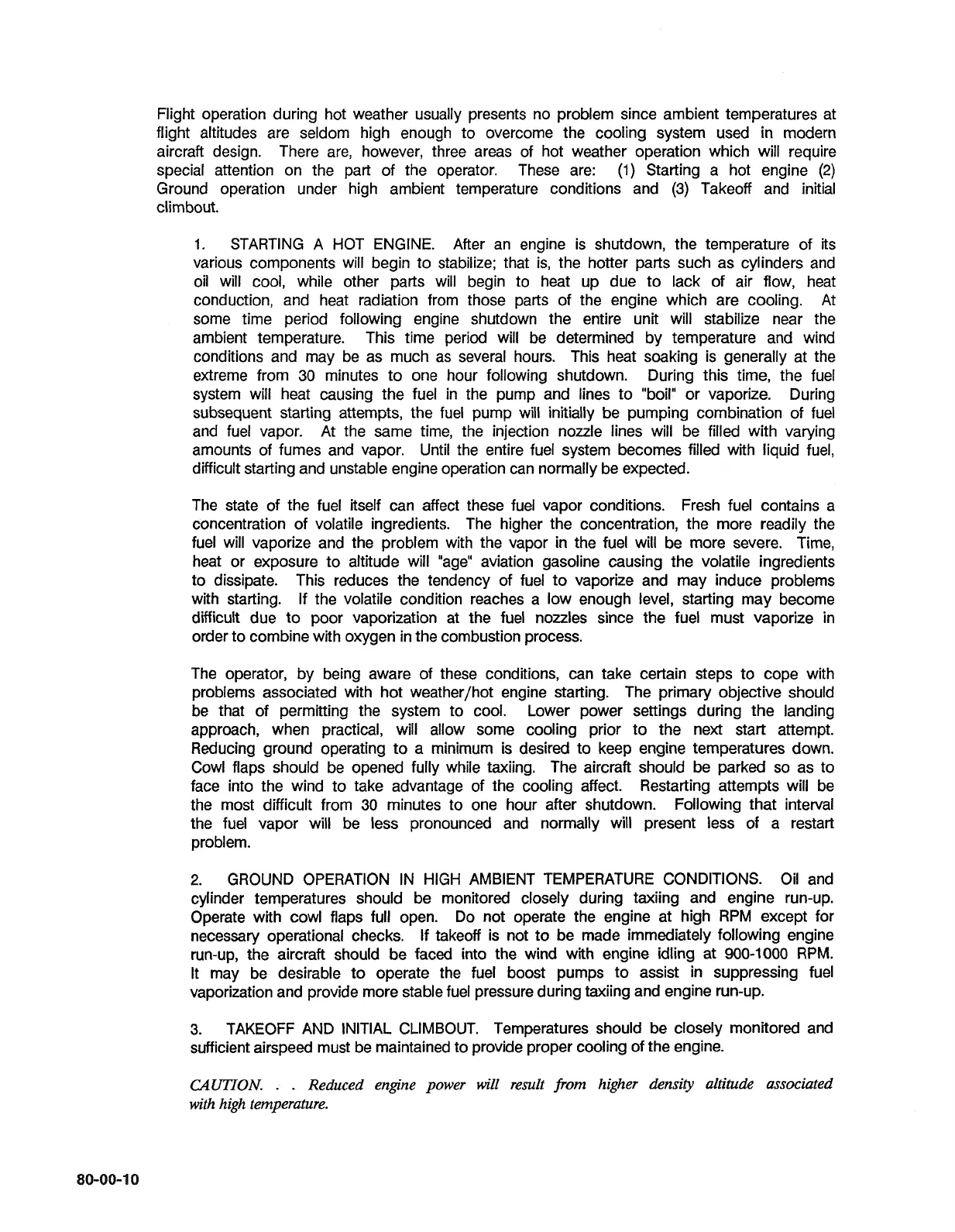Flight operation during hot weather usually presents no problem since ambient temperatures at
flighr altitudes are seldom high enough to overcome the cooling system used in modern
aircraft design. There are, however, three areas of hot weather operation which will require
special attention on the part of the operator. These are:
(1)
Starting a hot engine
(2)
Ground operation under high ambient temperature conditions and
(3)
Takeoff and initial
climbout.
1.
STARTING A HOT ENGINE. After an engine is shutdown, the temperature of its
various components will begin to stabilize; that is, the hotter parts such as cylinders and
oil will cool, while other parts will begin to heat up due to lack of air Row, heat
conduction, and heat radiation from those parts of the engine which are cooling. At
some time period following engine shutdown the entire unit will stabilize near the
ambient temperature. This time period will be determined by temperature and wind
conditions and may be as much as several hours. This heat soaking is generally at the
extreme from 30 minutes to one hour following shutdown. During this time, the fuel
system will heat causing the fuel in the pump and lines to "boil" or vaporize. During
subsequent starting attempts, the fuel pump
will initially be pumping combination of fuel
and fuel vapor. At the same time, the injection
nozzle lines will be filled with varying
amounts of fumes and vapor. Until the entire fuel system becomes filled with liquid fuel,
difficult starting and unstable engine operation can normally be expected.
The state of the fuel itself can affect these fuel vapor conditions. Fresh fuel contains a
concentration of volatile ingredients. The higher the concentration, the more readily the
fuel will vaporize and the problem with the vapor in the fuel will be more severe. Time,
heat or exposure to altitude will "age" aviation gasoline causing the volatile ingredients
to dissipate. This reduces the tendency of fuel to vaporize and may induce problems
with starting. If the volatile condition reaches a low enough level, starting may become
difficult due to poor vaporization at the fuel nozzles since the fuel must vaporize in
order to combine with oxygen in the combustion process.
The operator, by being aware of these conditions, can take certain steps to cope with
problems associated with hot
weather/hot engine starting. The primary objective should
be that of permitting the system to cool.
Lower power settings during the landing
approach, when practical, will allow some cooling prior to the next start attempt.
Reducing ground operating to a minimum is desired to keep engine temperatures down.
Cowl Raps should be opened fully while taxiing. The aircraft should be parked so as to
face into the wind to take advantage of the cooling affect. Restarting attempts will be
the most difficult from 30 minutes to one hour after shutdown. Following that interval
the fuel vapor will be less pronounced and normally will present less of a restart
problem.
2.
GROUND OPERATION IN HIGH AMBIENT TEMPERATURE CONDITIONS. Oil and
cylinder temperatures should be monitored closely during taxiing and engine run-up.
Operate with cowl flaps full open. Do not operate the engine at high RPM except for
necessary operational checks. If takeoff is not to be made immediately following engine
run-up, the aircraft should be faced into the wind with engine idling at 900-1000
RPM.
It may be desirable to operate the fuel boost pumps to assist in suppressing fuel
vaporization and provide more stable fuel pressure during taxiing and engine run-up.
3.
TAKEOFF AND INITIAL CLIMBOUT.
Temperatures should be closely monitored and
sufficient airspeed must be maintained to provide proper cooling of the engine.
CAUTION.
. .
Reduced engine power
wiZZ
result
from
higher density altitude associated
with high temperature.

